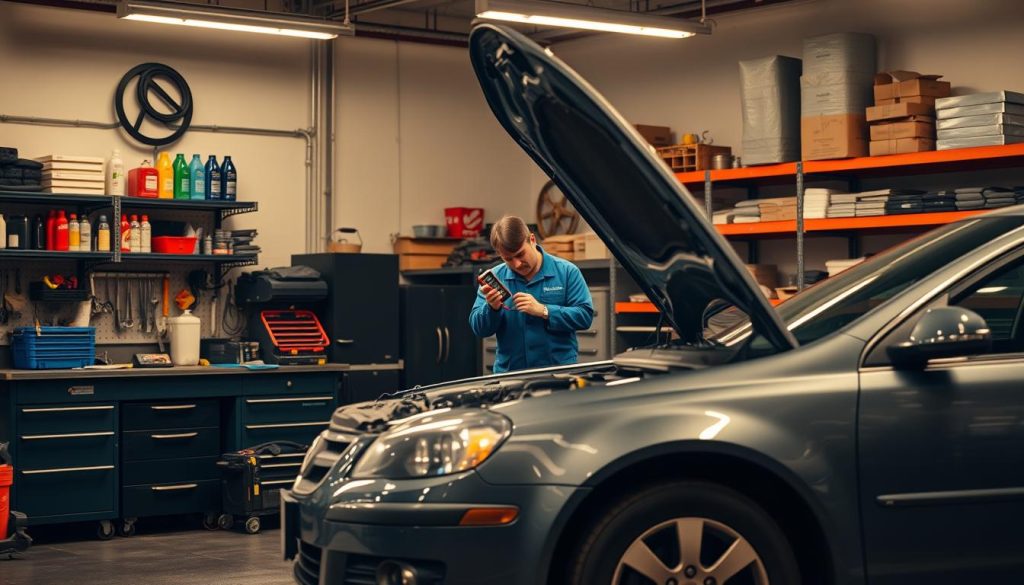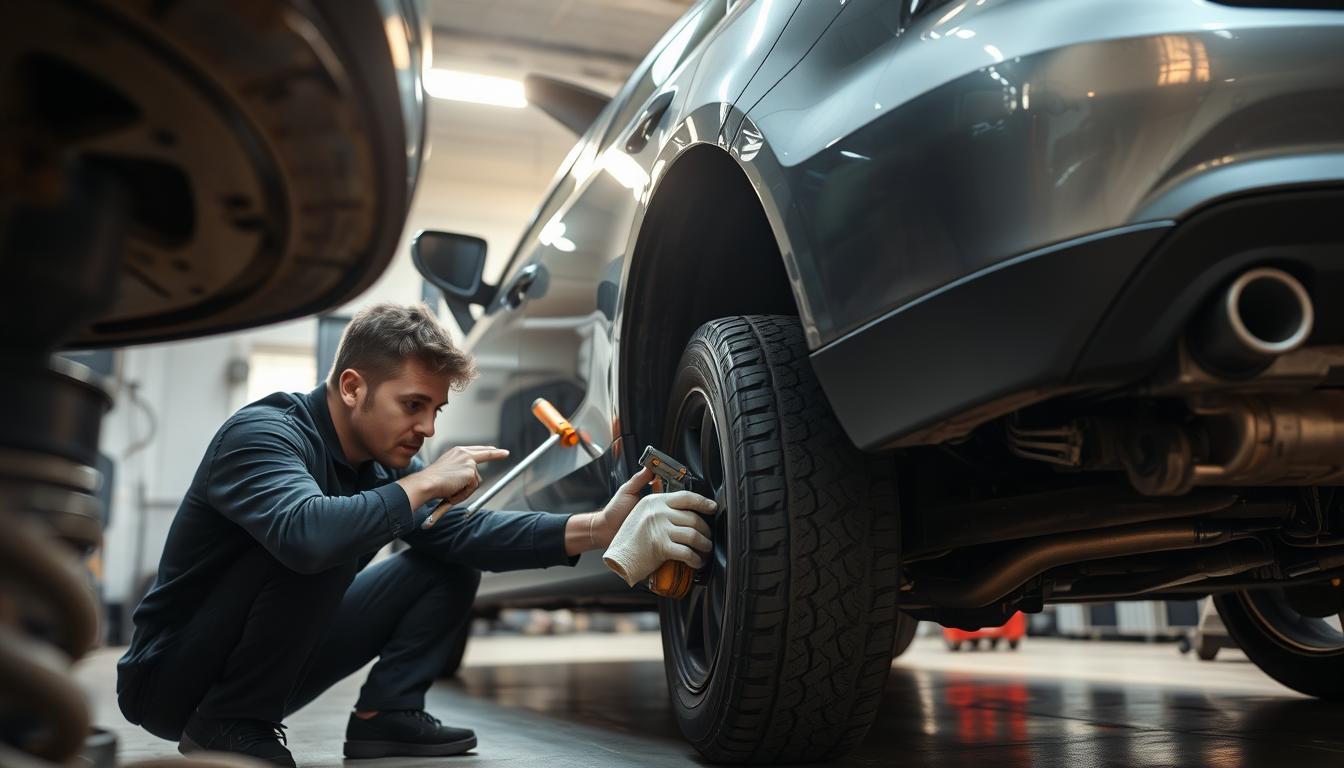Bringing home a pre-owned automobile can feel exciting yet overwhelming. You want to enjoy your new ride, but you also need to figure out which items demand immediate attention. Our team understands this balancing act perfectly.
Before diving into any fixes, consider a professional evaluation. According to industry experts like Consumer Reports, a thorough examination typically costs between $100-150. This small investment can reveal hidden concerns and potentially save you thousands down the road.
We’ve created this systematic guide to help you distinguish between urgent safety matters and less critical cosmetic flaws. Whether you’re inspecting the automobile yourself or working with a professional service, our approach makes the process straightforward.
Key Takeaways
- A professional vehicle examination is a smart first investment when purchasing a pre-owned automobile
- Safety-related issues like brakes and tires should always take priority over cosmetic concerns
- Understanding what needs immediate attention helps protect your investment and ensures safe driving
- Systematic evaluation helps you make informed decisions about maintenance budgeting
- Proper prioritization prevents unexpected breakdowns and extends your vehicle’s lifespan
- Working with experienced professionals can provide peace of mind throughout the process
Pre-Purchase Vehicle Inspection Insights
A smart buyer knows that a detailed look-over is a non-negotiable step before any purchase. As Nicole Miskelley, manager at PMR Auto & Diesel Repair, notes, this process allows an independent expert to spot damage or potential fixes a dealer might have missed. This insight is invaluable for making an informed decision.
Examining Exterior Condition and Body Repairs
We start our assessment with the automobile’s outer shell. A close look at the paint can reveal much about its history. Inconsistent color or texture often points to previous fixes you should know about.
We also search carefully for rust, especially around wheel wells and underneath. This is crucial when considering an automobile from a private seller in regions that use road salt. Misaligned body panels or uneven door gaps can be red flags for hidden frame issues.
Reviewing Interior Electronics and Safety Features
Inside the cabin, we test every feature. This includes power windows, locks, and the audio system. Electrical gremlins can be costly, so confirming everything works before you buy is a major advantage.
Be alert for musty smells or stained upholstery, as these can signal past water trouble. Most importantly, we verify that all safety components function correctly. Properly working seatbelts and airbag indicator lights are non-negotiable for your protection on the road.
Understanding the Used Car Repair Checklist
Having a structured approach to addressing your vehicle’s needs prevents overwhelm and protects your investment. We help you create a logical sequence for tackling maintenance items based on safety and importance.

Recognizing Essential Inspection Points
We begin by identifying critical safety components that require immediate attention. Brakes, tires, and lighting systems always take top priority in our evaluation process.
According to Julie Bausch Lent of Car Talk, checking service records and safety ratings provides valuable insight into a vehicle’s history. We also verify there are no outstanding recalls that could create safety issues.
Prioritizing Repairs Based on Common Issues
After addressing safety concerns, we focus on mechanical problems affecting reliability. Engine and transmission service needs come before cosmetic condition improvements.
We recommend getting estimates from a trusted shop for all identified issues. This helps you budget appropriately and decide which repairs to schedule immediately versus later.
Our systematic approach ensures you don’t overlook serious mechanical problems while focusing on minor appearance concerns. This protects both your safety and your automobile’s longevity.
Evaluating Mechanical Systems and Under the Hood Essentials
Our thorough evaluation of engine components and fluid systems provides critical insights into your purchase’s reliability. We focus on the mechanical heart of the automobile to identify potential issues before they become costly problems.
Assessing Engine Performance and Fluid Levels
We begin by checking all fluid levels throughout the vehicle. Low oil, coolant, or transmission fluid can signal leaks or neglected maintenance that need immediate attention.
When examining the engine oil, we look at both the level and condition. Burnt oil or a milky appearance suggests serious engine problems requiring professional assessment.
Checking Battery, Belts, and Radiator Conditions
The battery’s condition is critical for reliable starting power. We check terminals for corrosion and verify the charge level to ensure dependable performance.
We also inspect all belts and the radiator system carefully. Cracked belts or leaking coolant hoses can lead to breakdowns that leave you stranded unexpectedly.
DIY Inspection Tips and Test Drive Insights
Simple at-home tests combined with a strategic test drive provide valuable insights into a vehicle’s true condition. We believe every buyer should master these basic evaluation techniques.
Using the Penny Test for Tread Depth Accuracy
We start with the straightforward penny test to assess tire condition. Place a penny upside down in the tread grooves. If Lincoln’s head remains completely visible, the depth is unsafe and replacement becomes necessary.
Check the tread depth across the entire width of each tire. Uneven wear patterns may indicate alignment or suspension problems that need professional attention.
Observing Braking, Steering, and Suspension Feedback
During your test drive, we recommend planning a route with varied conditions. Include highway speeds, stop-and-go traffic, and different road surfaces. This comprehensive approach reveals how the automobile performs in real-world situations.
Listen carefully for brake squealing or grinding noises. Feel for pulsation in the pedal that could signal warped rotors. Steering should feel responsive without excessive play or pulling to one side.
Pay attention to how the suspension handles bumps. Unusual creaks or rattles suggest worn components. Verify the engine reaches normal temperature without overheating issues.
Service Records, Maintenance Schedules, and Safety Recalls
A vehicle’s paperwork tells a story that physical inspection alone cannot reveal. We consider documentation review an essential part of our evaluation process.
Reviewing Documentation and Title Status
We always verify title status through state motor vehicle departments. This ensures the automobile has a clean title with no liens or salvage history.
Vehicle history reports from services like CarFax provide valuable insights. They reveal accident history, service records, and previous ownership details.
Identifying Past Repairs and Recall Information
Checking for open safety recalls through NHTSA is critical. We confirm any recalls were completed at authorized facilities.
Service documentation shows whether previous maintenance followed manufacturer recommendations. Regular oil changes and transmission service prevent major mechanical issues.
Incomplete records require either deeper inspection or price negotiation. Thorough documentation review protects against hidden problems and legal complications.
Long Term Maintenance and Seasonal Check-Ups
Keeping your automobile running smoothly requires consistent attention to both immediate needs and seasonal changes. We believe establishing a regular maintenance rhythm helps prevent unexpected issues and extends your vehicle’s lifespan.

Short-Term Check-Ups: Oil, Coolant, and Lights
We start with simple monthly inspections. Checking oil and coolant levels takes just minutes but reveals potential leaks early. Always verify these fluids when the engine is cool for accurate readings.
Monthly light inspections ensure all headlights, turn signals, and brake lights function properly. Proper lighting is essential for safe driving in all conditions. We also check tire pressure monthly, remembering that air pressure drops with temperature changes.
Regular oil changes protect your engine’s health. While some vehicles need service every 3,000 miles, many modern automobiles with synthetic oil can go 5,000-10,000 miles between changes.
Seasonal Tasks: Tire Pressure, Wiper Replacement, and Fluid Exchanges
Seasonal maintenance prepares your vehicle for changing weather conditions. We replace windshield wipers annually for clear visibility during rain or snow. Battery performance checks before extreme temperatures help avoid starting problems.
Transmission fluid service becomes critical for high-mileage vehicles. If the fluid appears dark or smells burnt, we schedule an exchange to prevent transmission failure. For all-wheel drive systems, we also check transfer case and differential fluids.
Coolant system flushing removes contaminants that can affect engine temperature regulation. We verify coolant protection levels before winter to prevent freezing issues. Regular tire rotation promotes even wear and extends tire life.
Conclusion
Making informed choices about your new-to-you transportation investment ensures years of trouble-free driving. We’ve guided you through the complete evaluation process, from initial assessment to ongoing maintenance planning.
Remember that safety concerns like brake performance and tire condition always come before cosmetic matters. A thorough inspection reveals the true state of any pre-owned automobile.
Not every issue requires immediate service. Some can wait while others need prompt attention. Our systematic approach helps you budget wisely for both urgent fixes and future maintenance.
At Heaven Automotive, we specialize in addressing concerns identified during pre-purchase evaluations. Our technicians provide honest assessments and quality work that keeps your transportation running safely.
Don’t let maintenance worries overwhelm you. Trust Heaven Automotive to handle your vehicle’s needs with the care it deserves.

